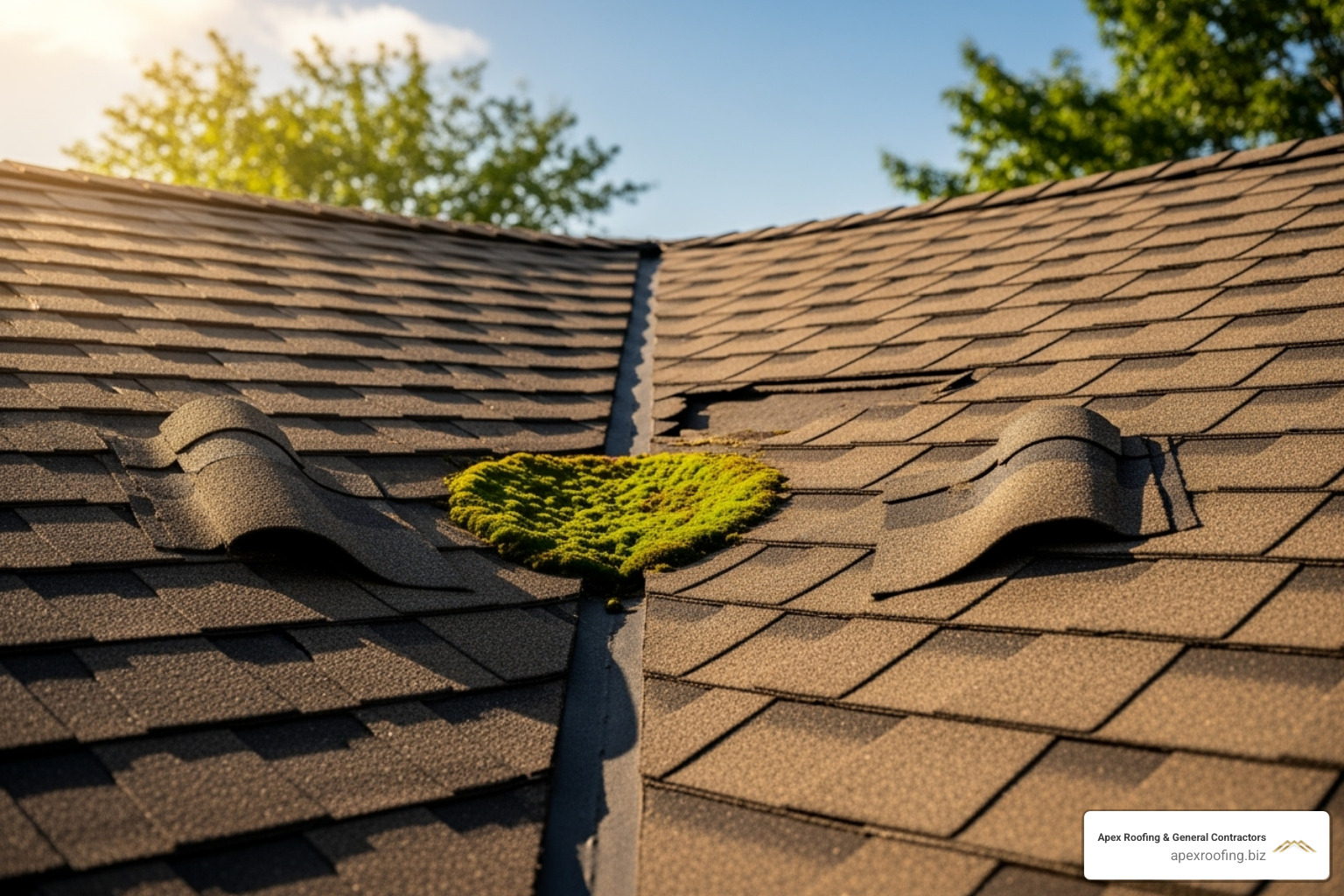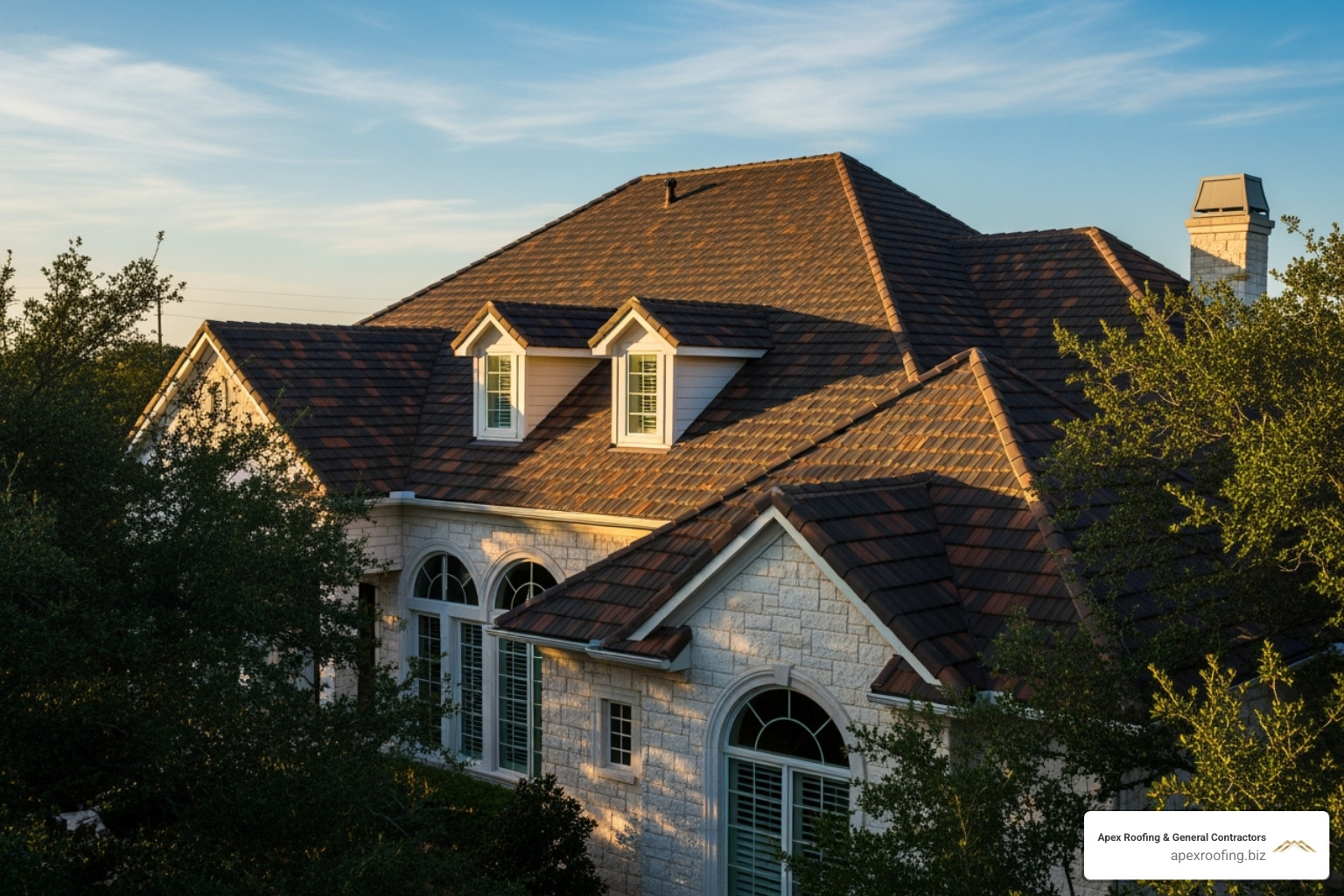When San Antonio Storms Strike: Your Immediate Action Plan
Roof storm damage San Antonio homeowners face is both predictable and devastating. Wind gusts reaching up to 59-60 mph, combined with hail storms that can cause billions in property damage, make swift action essential after every severe weather event.
If you’re dealing with storm damage right now, here’s what to do immediately:
- Stay safe – Don’t climb on your roof or enter damaged areas
- Document everything – Take photos and videos from the ground
- Cover exposed areas – Use tarps to prevent water intrusion
- Call your insurance company – File your claim within required timeframes
- Schedule a professional inspection – Hidden damage often exceeds visible signs
- Get multiple estimates – Compare repair vs. replacement options
- Check credentials – Verify licensing and insurance of contractors
- Act quickly – Delays can lead to mold, structural damage, and claim denials
The reality is stark: local roofing companies report being “inundated with nonstop calls” immediately after wind events, and homeowners who wait often face longer repair times and costlier secondary damage.
Missing or broken shingles, granule loss, dents from hail, and leaks are just the visible signs. Professional inspections reveal hidden vulnerabilities that untrained eyes miss – from lifted flashing to compromised decking that could fail during the next storm.
As Carlos Yzaguirre, President of Apex Roofing & General Contractors, I’ve guided countless San Antonio homeowners through roof storm damage San Antonio situations since co-founding our company in 2022. Our team combines advanced inspection technology with comprehensive storm damage repair services to protect your most valuable investment.
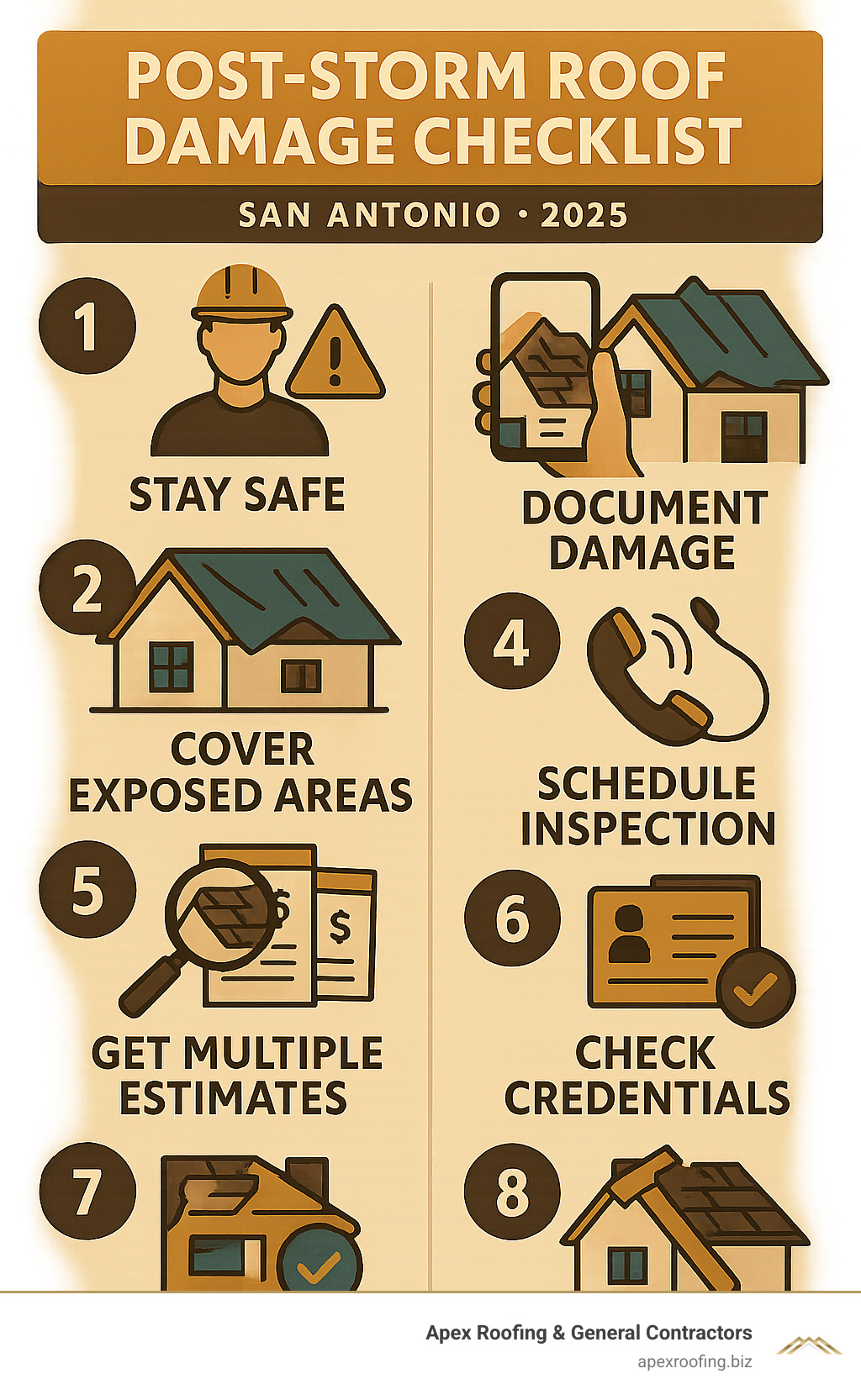
Glossary for roof storm damage San Antonio:
Understanding Storm Threats to San Antonio Roofs
Living in San Antonio means dealing with Mother Nature’s mood swings during storm season. Our unique spot in South Texas puts us right in the crosshairs of destructive weather patterns that can turn your peaceful home into a repair nightmare.
Wind gusts regularly clock in at 59-60 mph during major storms, creating “uplift forces” that can rip shingles off like paper. Hailstorms are equally brutal, pelting neighborhoods with ice chunks ranging from pea-sized to golf ball-sized roof destroyers. When hail reaches 1-2 inches in diameter, it creates significant damage that’s often invisible from your driveway.
Heavy rainfall combined with high winds creates a double-whammy effect. Once wind-driven rain finds gaps in compromised shingles or flashing, water gets a VIP pass into your home’s most vulnerable areas.
Most San Antonio homeowners’ insurance policies cover wind and hail damage. The key is understanding your coverage limits and deductibles before disaster strikes. That’s why we recommend scheduling professional roof inspections every 1-2 years – or immediately after severe weather events.
For detailed information about documenting storm damage, check out this scientific research on storm-related risk mitigation.
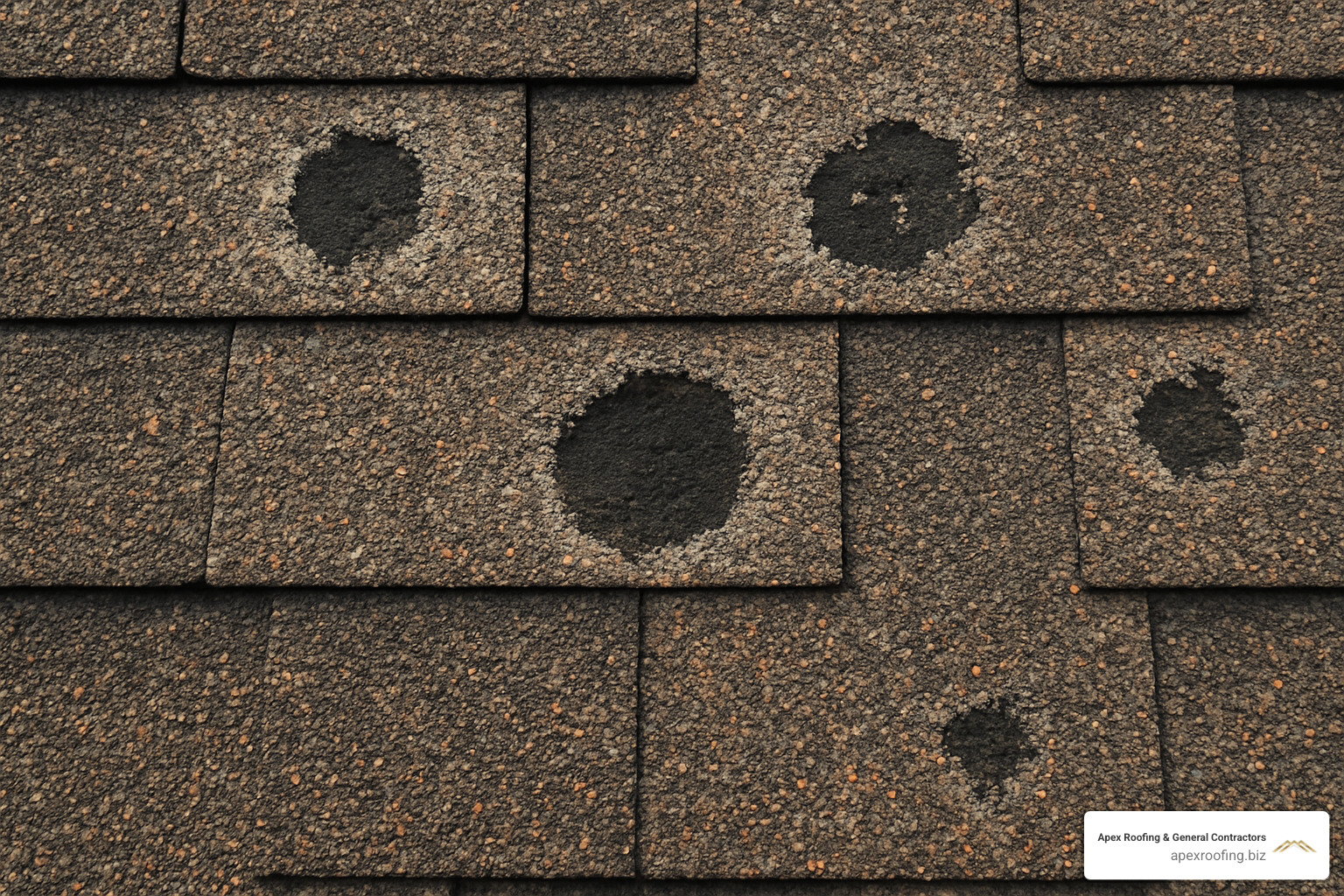
How South-Texas Weather Damages Roof Systems
Wind uplift happens when high-velocity air flows over your roof, creating low pressure above and high pressure below. This pressure differential starts ripping shingles off like Post-it notes.
Granule loss on asphalt shingles occurs when hail knocks loose the protective coating. Without granules, shingles become vulnerable to UV damage, losing waterproofing abilities and turning brittle.
Flashing around chimneys, vents, and skylights can tear, bend, or pull away during storms, creating direct highways for water infiltration. Gutter displacement creates water pooling around foundations, spreading problems beyond roof issues.
The Hidden Costs of Ignoring Minor Damage
What looks like “just a few missing shingles” can snowball into financial disaster. Water intrusion can saturate insulation, slash energy efficiency, and create perfect conditions for mold growth.
Saturated insulation becomes dead weight that causes ceiling joists to sag. Mold growth spreads through HVAC systems, requiring expensive professional remediation. Worst case? Structural rot in roof decking and rafters requires complex, expensive repairs that often necessitate complete roof replacement.
roof storm damage San Antonio: Visible & Hidden Warning Signs
When storms hit San Antonio, roof storm damage San Antonio homeowners experience isn’t always obvious from the ground. You might spot missing shingles scattered across your lawn, but the real story often lies in what you can’t see.
Missing shingles are nature’s calling card after severe storms. Bruised or dented shingles can fool you – they look fine from a distance but are covered in hail impact marks up close. Granule loss shows up as dark patches where protective coating has been knocked away.
Lifted flashing around chimneys, vents, and skylights might look fine from your driveway, but wind can bend, tear, or separate them from mounting points. When flashing fails, water has a direct highway into your home.
Attic leaks require detective work. Head to your attic with a flashlight and look for water stains on rafters, damp insulation, or musty smells. The daylight test is simple – any sunlight peeking through your roof deck means you’ve got holes needing attention.
Debris in gutters tells the damage story. Granules washing down downspouts aren’t just messy – they’re evidence of shingle damage. Pieces of flashing or roofing materials indicate storm impact.
Modern drone imagery allows our team at Apex Roofing & General Contractors to safely inspect every inch of your roof without ladder risks. We can spot damage patterns and assess overall condition far more comprehensively than ground-level observations.
For insurance purposes, proper documentation is crucial. Scientific research on documenting storm damage shows thorough evidence collection significantly improves claim success rates.

Quick Ground-Level Checks for roof storm damage San Antonio
Your damage assessment starts with a simple property walk-around. Shingle pieces scattered across your lawn often show manufacturer markings that help identify which roof sections took the biggest hit.
Granules in downspouts shouldn’t wash off in large quantities unless something knocked them loose. Fresh granules match your shingle color and might clog downspout outlets if damage was severe.
Smart trick: check your AC unit’s fins and other metal components. If they’re dented, your roof probably is too. Hail hits everything equally, providing valuable supporting evidence for insurance claims.
In-Depth Professional Findings of roof storm damage San Antonio
Professional inspections reveal damage homeowners miss every time. Soft spots in roof decking feel spongy and indicate water penetration compromising structural integrity. Deck exposure occurs when shingles get completely ripped away, leaving plywood sheathing vulnerable to sun and rain damage.
Ridge vent cracks are nearly impossible to spot from ground level but compromise ventilation and energy efficiency. Moisture meter readings provide objective data identifying areas that look dry but harbor internal moisture – hidden damage leading to expensive surprises later.
At Apex Roofing & General Contractors, we understand roof storm damage San Antonio homeowners face requires immediate attention and long-term solutions. Our comprehensive storm damage repair services address every damage type, from obvious missing shingles to hidden structural compromises.
First 24 Hours: Protect, Document, and File Claims
When storms hit San Antonio, the first 24 hours after roof storm damage San Antonio occurs can make or break your insurance claim and determine whether minor damage becomes major problems.
Safety comes first, always. Never climb on damaged roofs or enter areas with suspected structural damage. If you see water near electrical outlets, shut off power to those areas immediately.
Emergency tarping is your first defense against additional water damage while arranging permanent repairs. However, damaged roofs are unpredictable – securing tarps properly requires specialized equipment and experience.
Documentation starts now and is critical for insurance claims. Take photos and videos systematically – wide shots showing overall damage patterns, then close-ups of specific problems. Your smartphone’s automatic timestamps and GPS coordinates provide valuable evidence. Store everything in cloud-based systems immediately.
Insurance companies are strict about filing deadlines – typically 30-60 days after storm events. Don’t wait; call your insurance company as soon as it’s safe to assess damage. The sooner you file, the sooner repairs can start.
Having a qualified roofing contractor present during insurance adjuster inspections makes a huge difference. They spot damage adjusters might miss and ensure everything gets properly documented.
If you’re dealing with roof storm damage San Antonio right now, our emergency roofing team is available 24/7 for urgent situations.
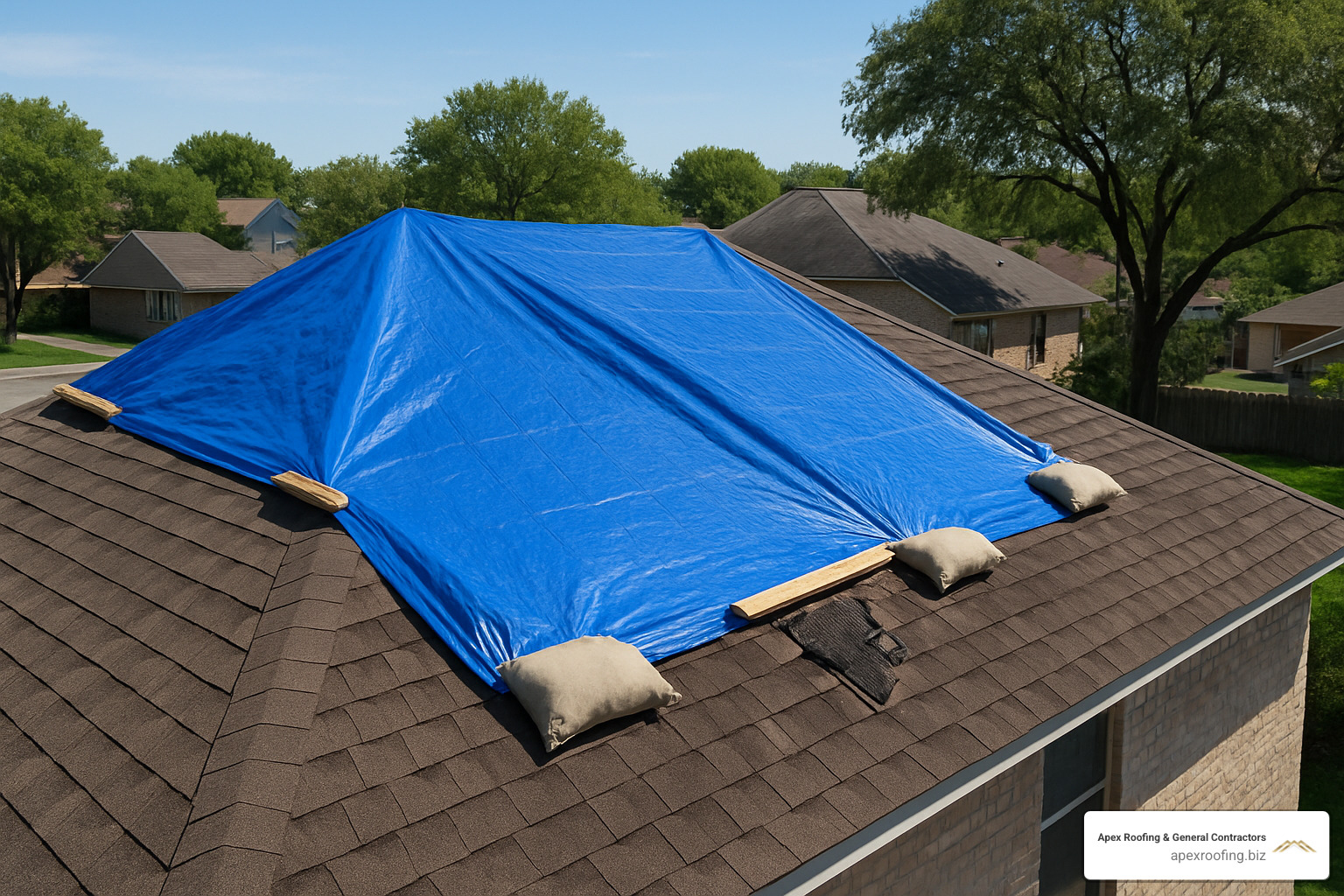
Step-by-Step Storm Claim Filing in Bexar County
Start with policy review before calling. Understand coverage limits, deductibles, and storm-specific requirements. Pay attention to time limits – some policies have surprisingly short filing windows.
File claims immediately once damage is assessed. Be specific about what you see: missing shingles, water stains, hail dents, or other identified damage.
Schedule adjuster inspections quickly. After major storms, adjusters get swamped. Early appointments move claims forward faster.
Get detailed repair estimates from licensed contractors – multiple estimates help ensure fair pricing and many insurers require them.
Homeowner Documentation Tips
Your smartphone is your most powerful documentation tool. Modern phones automatically embed timestamps and GPS coordinates – invaluable metadata for insurance claims.
Think like a detective – capture wide-angle shots showing damage scope, then close-ups revealing specific problems. Cloud storage isn’t optional – upload photos and videos immediately to prevent loss.
Collect neighbor witness statements who saw the storm or aftermath. Simple written statements with contact information add claim credibility.
Repair vs. Replacement: Choosing the Right Restoration Path
When roof storm damage San Antonio homeowners face the repair-or-replace decision, understanding key factors can save thousands of dollars and years of headaches.
Damage extent is your starting point. If storm damage affects more than 25-30% of roof surface, replacement typically becomes the smarter financial move.
Roof age tells an important story. Asphalt shingle roofs generally last 20-25 years in Texas climate, while metal roofs exceed 50 years. If your roof is already 15+ years old and took storm damage, replacement might provide better long-term value.
Material availability can surprise homeowners. If current shingles are discontinued or hard to match, partial repairs create patchwork appearances affecting home value.
Building code compliance might force decisions. Current codes often require upgrades during major repairs. Sometimes bringing everything up to code costs almost as much as complete roof replacement.
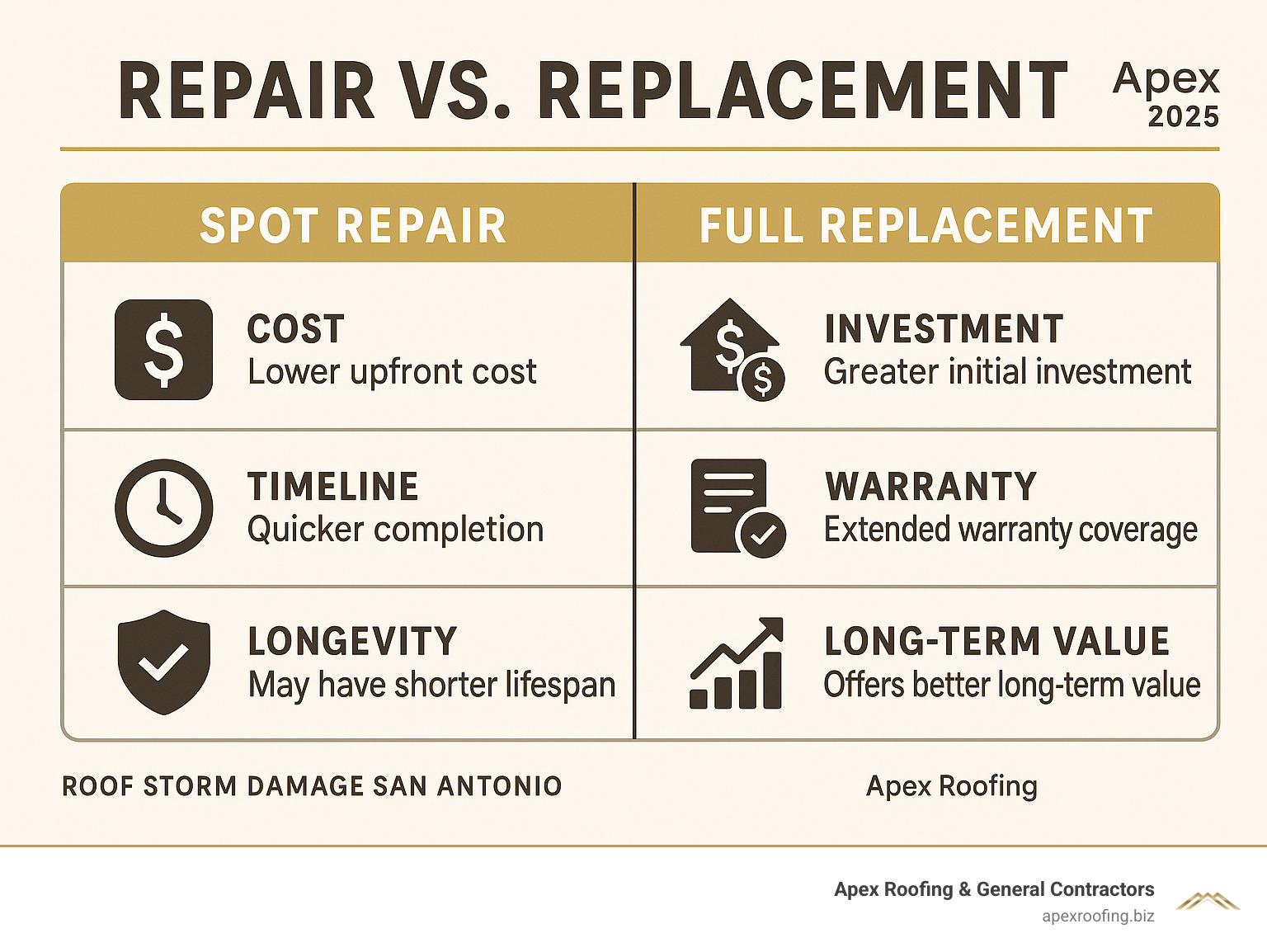
Financing & Warranty Options for Budget-Smart Fixes
Insurance proceeds form most storm damage financing backbone. Replacement cost coverage typically provides better protection than actual cash value policies.
Deductible planning shouldn’t be afterthought. High-deductible policies reduce monthly premiums but increase immediate out-of-pocket expenses. Ensure sufficient emergency funds to cover deductibles before disasters strike.
Apex Roofing & General Contractors offers comprehensive financing options helping San Antonio homeowners manage repair costs. These programs bridge gaps between insurance proceeds and total project costs.
Transferable warranties add real investment value and can increase home resale value. Quality material and workmanship warranties protect investments long-term.
Selecting Materials That Withstand the Next Storm
Impact-resistant shingles represent smart upgrades for our storm-prone region. Class 4 impact-resistant shingles withstand hail impacts that destroy standard shingles, and many insurers offer premium discounts.
Metal roofing provides superior wind and hail resistance. While initial investment is higher, metal roofs often last 50+ years with minimal maintenance, making them incredibly cost-effective over their lifetime.
Underlayment upgrades create additional protection layers. Synthetic underlayments offer superior tear resistance and waterproofing compared to traditional felt paper.
For detailed information about durable roofing options, explore our asphalt shingle roofs and metal roofs services.
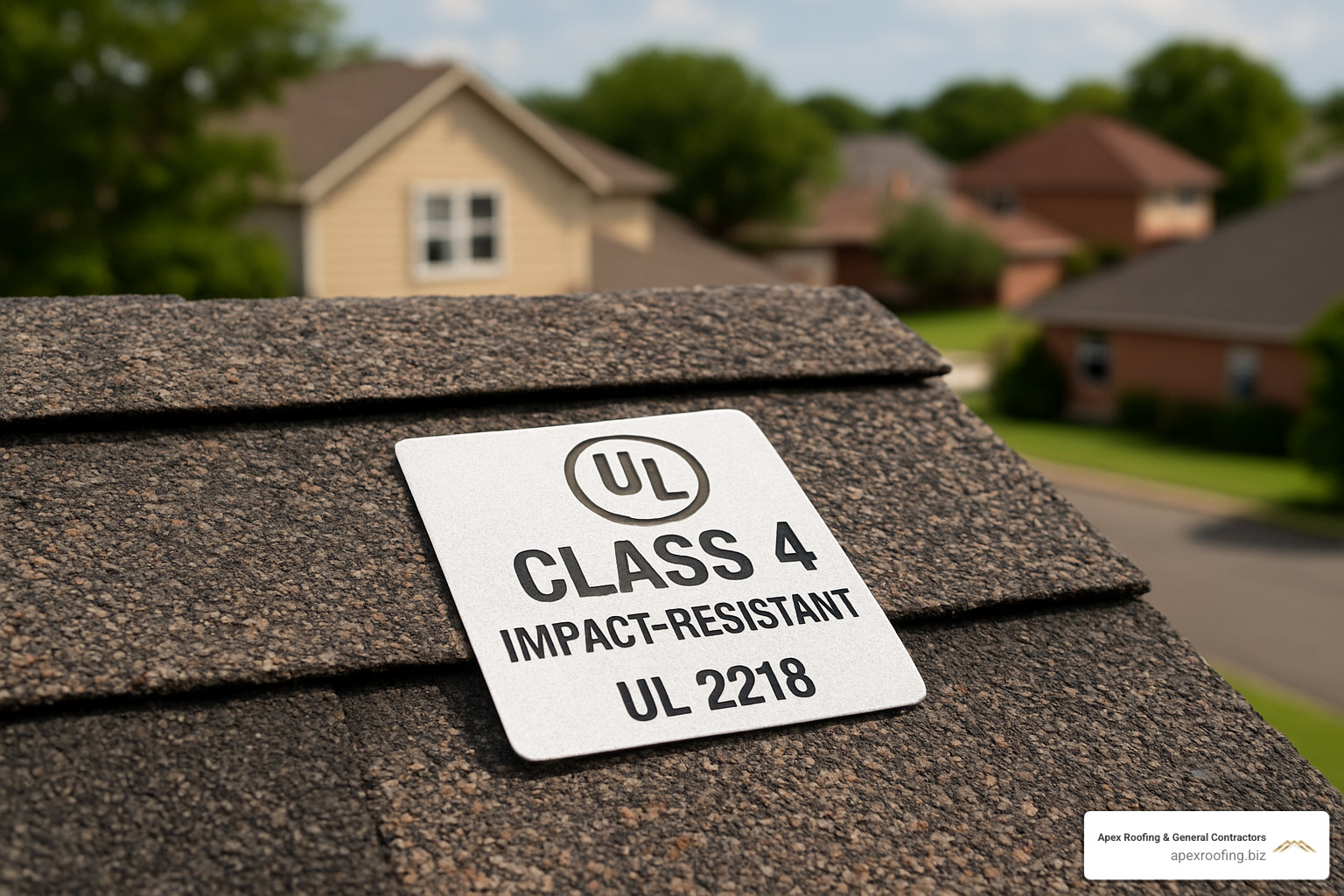
Preventing Future Storm Losses & Hardening Your Roof
The best defense against roof storm damage San Antonio homeowners face is proactive maintenance and strategic upgrades. Think of it as storm-proofing your home before nature tests your defenses.
Annual inspections serve as early warning systems, catching small problems before they become expensive disasters. Schedule professional inspections in early spring before storm season and again in fall after weather calms down.
Tree trimming might seem like landscaping, but it’s crucial roofing investment. Dead or overhanging branches become projectiles during high winds. Keep at least 10 feet clearance between tree branches and roof surfaces.
Gutter maintenance prevents water backup under roofing materials during heavy storms. Clean gutters seasonally and check proper slope and secure mounting.
When planning major roof work, consider impact-resistant upgrades even without full replacement. Class 4 impact-resistant materials provide significant hail protection, and many insurers offer premium discounts.
Attic ventilation improvements protect roofs from inside out, reducing heat buildup that weakens materials and preventing moisture accumulation leading to mold and structural damage.
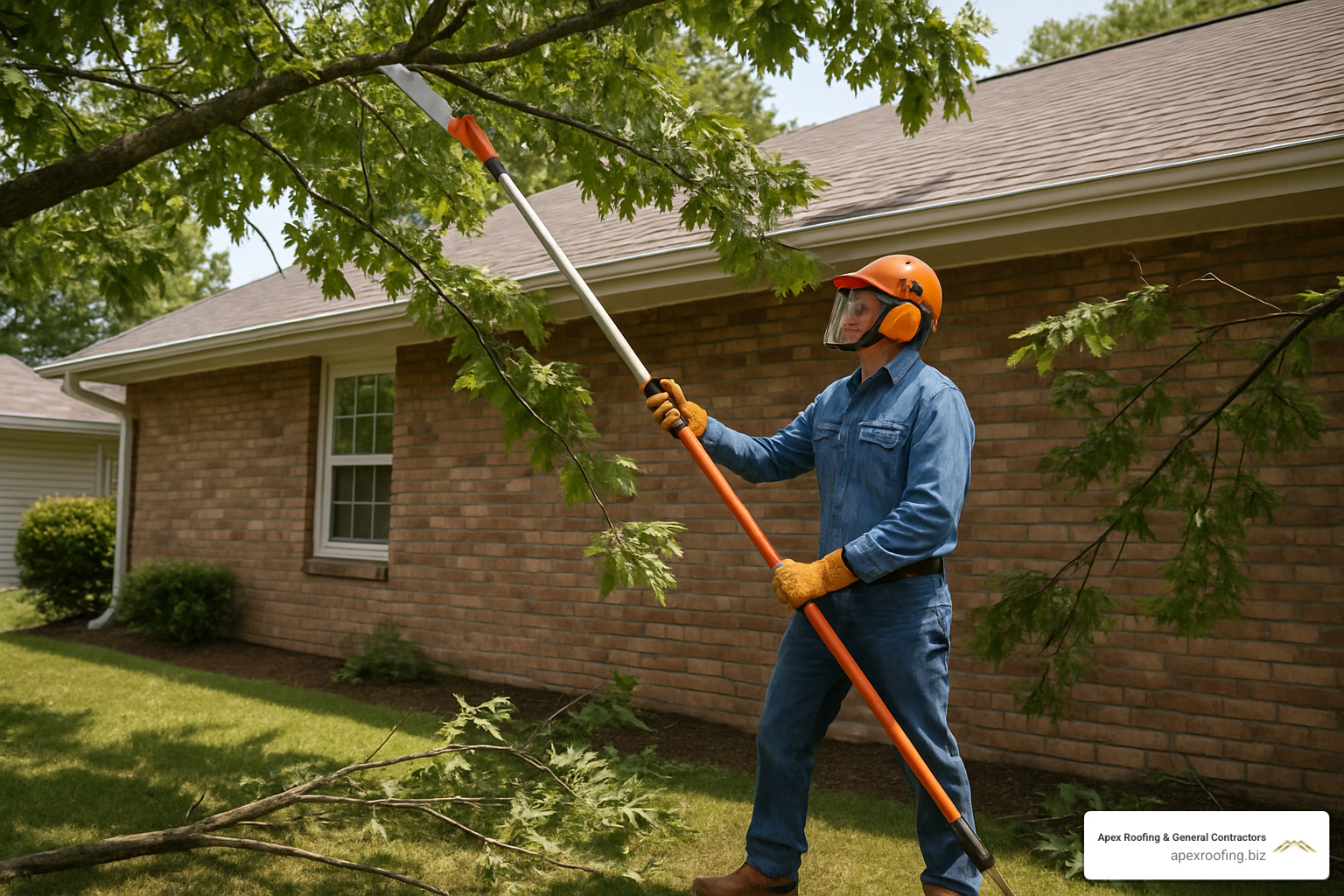
Roof Maintenance Plan for Commercial & Residential Properties
Bi-annual inspection checklists should cover every major roofing system component. Document findings and note changes from previous inspections.
Seasonal gutter clean-outs deserve special attention in our climate. Schedule cleanings in late fall after leaves finish falling and early spring before heavy rains begin.
Maintenance logs prove invaluable for warranty claims and insurance purposes while helping track roof condition over time.
Whether residential or commercial property, we provide comprehensive maintenance programs custom to specific needs and budgets. Our commercial roofs services include customized maintenance schedules.
Community Resources & Weather Alerts for Early Action
NOAA Weather Radio and mobile apps provide real-time alerts for severe storms in your area. Set up automatic notifications to avoid being caught off guard.
Bexar County emergency management offers multiple channels for local weather alerts through social media, websites, and emergency alert systems.
When storms strike and you need rapid response for roof storm damage San Antonio properties, our team serves the entire area including Helotes, Leon Valley, Alamo Heights, Fair Oaks Ranch, Shavano Park, Terrell Hills, and throughout Bexar County. Contact our roofers near me in San Antonio for immediate assistance.
Frequently Asked Questions about Storm-Damaged Roofs in San Antonio
How quickly should I fix a leak after a storm?
Time is critical when dealing with roof storm damage San Antonio leaks. Address any leak within 24-48 hours of findy – this isn’t just recommendation, it’s essential for protecting your home and wallet.
Even “small” leaks can cause thousands in damage if you wait. Water spreads through insulation, soaks into wood framing, and creates perfect mold environments. What starts as a $200 shingle repair can quickly become a $5,000 problem involving new decking, insulation replacement, and interior repairs.
Emergency tarping buys time while arranging permanent repairs, but don’t let temporary fixes become permanent neglect. Our emergency roofing team is available 24/7 to prevent small problems becoming big disasters.
Will my insurance premium rise if I file a storm claim?
Weather-related claims typically shouldn’t increase premiums because storms are “acts of nature” – completely beyond your control. However, multiple claims within short periods might raise flags with insurers.
Here’s what matters: the cost of not filing claims is almost always much higher than potential premium increases. If you have $15,000 storm damage and worry about potential $200 annual premium increases, you’re choosing to pay 75 times more to avoid small rate adjustments.
Plus, if you don’t repair storm damage promptly and it leads to secondary damage like mold or structural issues, insurers might deny coverage since problems resulted from neglect rather than original storms.
When does storm damage require a full roof replacement instead of repairs?
Full roof replacement typically becomes smart choice when damage affects more than 25-30% of roof surface. Age plays huge roles – if roofs are already 15-20 years old with significant storm damage, replacement often provides better long-term value.
The “50% rule” is important – if repairs cost more than half of replacement costs, replacement usually makes more financial sense. Structural damage to roof decking, widespread granule loss, or damage to critical components often indicate comprehensive replacement is most cost-effective.
We help homeowners steer decisions by providing detailed assessments considering current damage and overall roof condition. Our roof replacement services include comprehensive evaluations ensuring informed decisions.
Whether you need targeted storm damage repair or complete replacement, we’ll guide you through the process and work directly with insurance companies.
Conclusion
When roof storm damage San Antonio strikes your home, every hour you delay addressing damage increases the risk of water intrusion, mold growth, and structural problems that cost far more than prompt repairs.
At Apex Roofing & General Contractors, we have guided countless San Antonio-area homeowners through every step of storm-damage recovery. From that first anxious moment spotting missing shingles to final cleanup after repairs, we make the process smooth and stress-free.
Our team handles the heavy lifting—coordinating with insurance adjusters, documenting damage thoroughly, and ensuring all work meets current building codes. We speak the insurance company’s language and know exactly which details speed up claim approval.
What sets us apart is transparent communication. We explain each step in plain English, provide detailed estimates with no hidden costs, and keep you informed throughout the project. No surprises, no runarounds—just honest, professional service.
Whether you need emergency tarping, targeted storm damage repair, or a complete roof replacement, we bring the same commitment to quality workmanship on every job. Our certified technicians use advanced inspection technology to catch damage others miss, ensuring repairs address both visible problems and hidden vulnerabilities.
Don’t let storm damage turn into bigger headaches. Waiting almost always costs more than taking prompt action. Water damage, mold remediation, and structural repairs can quickly spiral into expenses that dwarf the original repair cost.
Ready to restore your roof—and your peace of mind? Contact our local experts at (726) 727-7663 today for a free estimate and professional inspection. We proudly serve San Antonio, Helotes, Leon Valley, Alamo Heights, Fair Oaks Ranch, Shavano Park, Terrell Hills, and all of Bexar County. To schedule fast assistance, visit our Roofers Near Me in San Antonio page and reach out through the contact form. Your home is your biggest investment—protect it with San Antonio’s trusted roofing professionals who put your needs first, every time.


